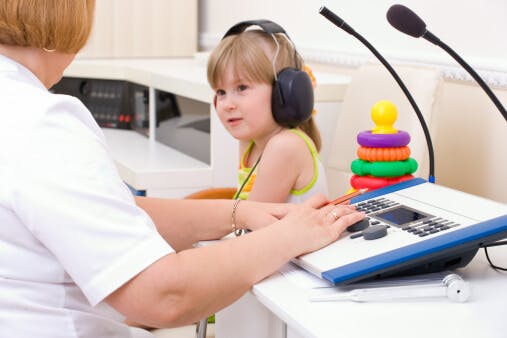Deafness: A-to-Z Guide from Diagnosis to Treatment to Prevention

Introduction:
In that first golden moment when you gazed at your baby in the delivery room, he was already beginning an amazing journey of learning. And how do children learn? They take in the world by using their five senses. The sight of your face, the feel of your touch, the taste of your milk, the scent of your unique aroma, and the sound of your voice combine to teach your child about the world.
Some children enter the world in silence.We now know that hearing loss can significantly impair the ability to learn — not just learning to speak but also to walk, to read, to write, to do well in school and to get along well with others.
The sooner hearing loss is detected and addressed; the better children will do overall.
What is deafness?
In a healthy ear, sound waves enter the ear canal and vibrate the eardrum at the end of the canal. The eardrum transmits the sound waves across the three tiny bones of the middle ear into the inner ear, where the information is converted to electrical impulses that travel along nerves to the brain, allowing us to hear.
There are two main types of hearing loss.
In conductive hearing loss, children have a problem transmitting sound waves through the outer ear, through the eardrum, or through the tiny bones of the middle ear.
In sensorineural hearing loss, the problem is with converting sound waves to electrical impulses, or in transmitting this electrical sound information along the auditory nerves to the brain.
Either conductive or sensorineural hearing loss may be present at birth, or may be acquired along the way. Hearing loss may be mild, complete, or somewhere in between.
Who gets deafness?
Usually severe sensorineural hearing loss in childhood is genetic (it runs in families – even if this child is the first). Sometimes, however, sensorineural hearing loss is a result of other problems, such as a rubella or CMV infection during pregnancy or meningitis infections later on.
Each year about 20,000 children in the United States are born with permanent hearing loss. Often this isn’t discovered until the children are 3 years old and their language is noticeably delayed.
But these 20,000 children with congenital hearing loss are only the tip of the iceberg. In April 1998, the Journal of the American Medical Association reported a staggering 7 million children in the United States with hearing loss significant enough to impair the ability to learn. Most of these children have temporary hearing loss, but even though the hearing loss is temporary, the impact can last a lifetime.
The most common cause for temporary hearing loss is the fluid in the middle ear space associated with ear infections. Whenever a child has an ear infection, germ-containing fluid enters the middle ear space from the back of the nose or throat. The eardrum can’t vibrate freely, resulting in a 15 to 40 decibel hearing loss.
What are the symptoms of deafness?
Hearing loss may be suspected in children who don’t startle to loud sounds or don’t turn to look for the source of sounds. Babies who don’t seem to notice you until they see you may have some form of hearing loss.
Speech development in babies with hearing loss may be unusual. They will often focus on gargling, vibrating noises that they can feel. Speech delay at any point suggests hearing loss as a possibility.
Language development during the first few years of life is nothing short of amazing! A child is born unable to understand any words, and yet is speaking in complete sentences within a few years. During this flowering of development, there are certain critical windows when different sounds are learned. For instance, someone who reaches 8 to 10 months of age without hearing Chinese will lose the ability to distinguish between some of the vocal sounds of that language.
Sometimes the language you miss out on hearing is your own! The most common age for temporary hearing loss is during that same precious time when the miracle of language development is unfolding.
Is deafness contagious?
Not directly.
How long does deafness last?
Some hearing loss is permanent. The most common form of hearing loss is quite brief – but casts a long shadow. On average, fluid lingers for 3 weeks following an ear infection, but it can remain for months at a time. Usually, 12 weeks of fluid is considered the cut-off for concern. However, some investigators have been able to detect long-term language delays (noticeable 9 years after the fact) in children who had 8 or more weeks of fluid between 6 and 12 months of age.
How is deafness diagnosed?
Without a newborn hearing test, the average age at which congenital deafness is diagnosed is 2 years old! Children whose deafness is treated in the first months of life gain critical time and perform far better on developmental tests than those whose diagnosis is delayed. It’s no surprise that the National Institutes of Health and the American Academy of Pediatrics both recommend that all babies have their hearing tested, preferably before they first leave the hospital.
How is deafness treated?
The treatment of hearing loss depends on the cause.
Temporary conductive hearing loss is often treated by properly managing the ear infections. For other types of hearing loss, treatment might involve reconstructive surgery, hearing aids, or cochlear implants (replacement inner ears). Sign language may become important to learn for the child – and for friends and family.
How can deafness be prevented?
All too often, hearing loss cannot be prevented. However, preventing congenital infections, preventing ear infections, preventing meningitis, and preventing hearing damage from exposure to loud noises can all help to preserve hearing.
Related concepts:
Hearing loss, Conductive hearing loss, Sensorineural hearing loss.


